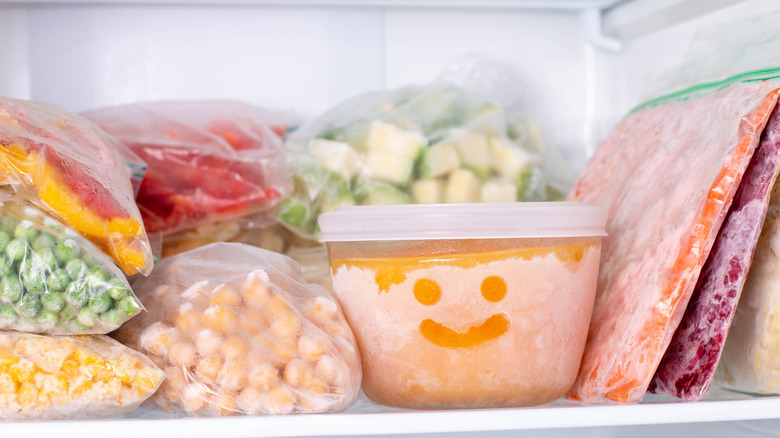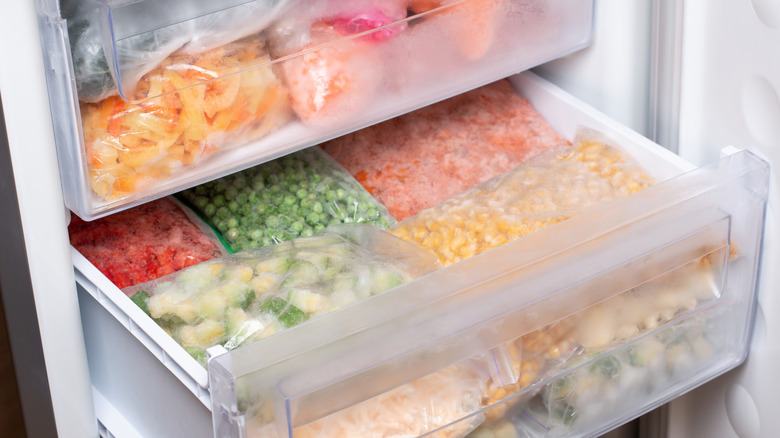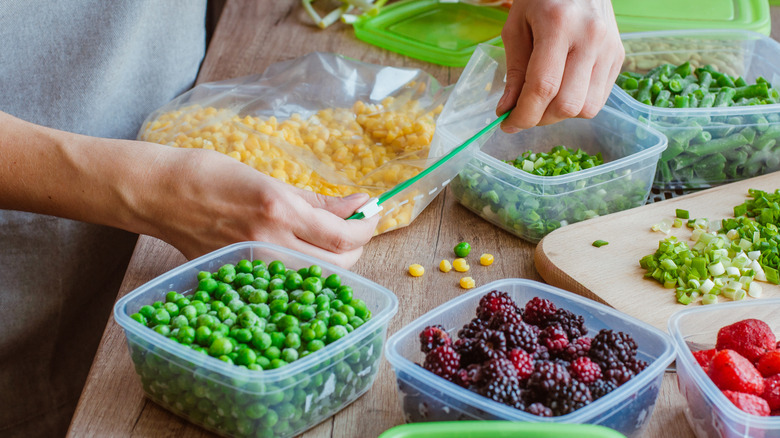The Reason Rapid Freezing Is Better For Food Than Slow Freezing
Home cooking had gotten a whole lot easier in 1921, when thousands of non-industrial refrigerators were manufactured in the U.S. and installed in American kitchens for the first time, per History Magazine. Mechanical fridges steadily became more ubiquitous over the following decades, giving way to advanced features like automatic defrosting and ice-making in the 1950s and '60s, per History of Refrigeration. As time went on, fridge designs would only get smarter and more efficient.
There's no doubt that the modern fridge changed the game, but Whirlpool says it wasn't until the 1940s that the machine gained its missing component en masse: the freezer. If William Carlos Williams wrote his famous poem "This Is Just To Say" in 1945 as opposed to 1938, he might have replaced the term "icebox" with "deep freeze," the innovation's original moniker.
Despite the supposed simplicity of the home freezer in the present day, however, proper preservation isn't always as simple as throwing food in the freezer all willy-nilly. Here's why it matters whether you freeze your food rapidly or slowly.
Beware of ice crystals
When you're craving a bowl of ice cream, there's nothing worse than opening a pint of your favorite Ben & Jerry's flavor only to discover that its texture has changed completely and it's been taken over by a patchy sheet of ice, aka freezer burn. As food preservation expert Martha Zepp writes for PennState Extension, this sad state of dehydration is caused by a process that occurs when water — found in almost everything we eat — reaches freezing temperature. Zepp explains that water then lets off a small amount of heat, allowing for the formation of ice crystals that leave behind dehydrated food. This is exacerbated during an appliance's freeze-thaw cycle.
"Because foods are a complex mixture of many substances, their freezing point is below the freezing point of water," and every food freezes in its own way, she reveals. The Library of Congress adds that water crystals in food are attracted to the coldest places they can find, which often means the side of your freezer. When food is stored improperly, especially if exposed to air, those water molecules seek the chill and abandon the food to dry out.
What does this mean for your leftover veggies, meat, nuts, and ice cream? Essentially, it means you want to prevent those crystals from forming as best you can. To do this, Zepp recommends "rapid freezing," which results in smaller ice crystals that "do less damage to cell walls" in your food. Here's how to do it.
How to avoid freezer burn
Some crystals are said to have healing properties, but ice crystals have the opposite effect on the unsuspecting denizens of your freezer. Luckily, Martha Zepp has a number of suggestions to safeguard against freezer burn. For starters, to freeze food rapidly, she says to keep your freezer at least at zero degrees Fahrenheit so large crystals don't have the chance to form. If you can, set your freezer temp to 10 degrees lower than you normally would if you're storing large amounts of food (Thanksgiving leftovers, anyone?). Zepp also warns against opening the freezer too often, which lets in warm air, causes the temperature to fluctuate, and contributes to the formation of large crystals through the subsequent thawing-and-refreezing process.
Other simple tips for avoiding freezer burn include using freezer-safe plastic bags, which will keep your food safe from vapor and outside air, and sealing those bags tightly. Finally, Zepp suggests that you "minimize headspace in plastic containers" by placing a piece of plastic wrap or waterproof paper on top of frozen fruit, "over-wrap" meat with freezer paper or aluminum foil, and choose a manual defrost freezer rather than one that goes through an automatic freeze-thaw cycle. (And beyond all those precautions, keep in mind that some foods shouldn't be stored in the freezer to begin with.) MasterClass also recommends letting items — especially hot foods — hang out in the fridge to cool down before going in the freezer, to prevent the uneven freezing and water migration that can cause freezer burn.


